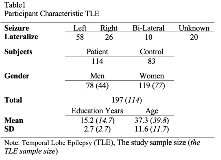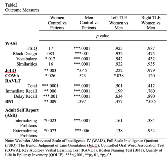Epilepsy Connectome Project (ECP) – Cognitive Gender Differences in Temporal Lobe Epilepsy
Abstract number :
1.37
Submission category :
11. Behavior/Neuropsychology/Language / 11A. Adult
Year :
2019
Submission ID :
2421363
Source :
www.aesnet.org
Presentation date :
12/7/2019 6:00:00 PM
Published date :
Nov 25, 2019, 12:14 PM
Authors :
Leroy M. Williams, University of Wisconsin–Madison; Gyujoon Hwang, University of Wisconsin-Madison; Gengyan Zhao, University of Wisconsin-Madison; Bruce P. Hermann, University of Wisconsin-Madison; Aaron F. Struck, University of Wisconsin-Madison; Veena A
Rationale: Temporal lobe epilepsy (TLE) is the most prevalent form of focal seizures. Studies have shown that cognitive anomalies in TLE can be widespread in some patients including memory, language, praxis, executive functions, and social judgment, among several others (Zhao et al., 2014; Hermann et al., 2007). However, little is known regarding sex differences in cognition when examining right and left TLE. Studies suggest that women show an advantage in verbal memory, and men show an advantage in figural memory (Helmstaedter, 1999). Furthermore, imaging studies argue that women with left TLE show increased seizure severity and frequency during menstruation, suggesting that gender may influence patterns of neuronal communication (Quigg et al., 2009). The objective of this study is to investigate cognitive gender differences among adult patients with right or left TLE in the context of the Epilepsy Connectome Project (ECP). Methods: Participants (n=107, mean age=37 yrs, mean education 15.2 yrs) included 114 TLE patients (77 women and 44 men) and 83 controls. Seizure laterality based on interictal or ictal EEG among TLE participants was as follows: 58 right, 26 left, 10 bilateral, 20 uncertain. Participants with bilateral and uncertain seizure laterality were excluded from the study. Neuropsychological tests included measures of intelligence, perception, verbal fluency, object naming, and language (Wechsler Abbreviated Scale of Intelligence-IV (WAIS) subtests, The Benton Judgment of Line Orientation [JoLO], Controlled Oral Word Association Test [COWA], Rey Auditory Verbal Learning Test [RAVLT], Boston Naming Test [BNT]). Neuropsychological data were processed using IBM SPSS Statistics v25. One-way ANOVA compared men TLE X controls, women TLE X controls, right TLE women X men, and left TLE women X men. Results: No significant differences were observed between men and women for right or left TLE in the majority of the traditional neuropsychological tasks. However, right TLE showed significance in the Boston Naming Test (p = 0.035) and left TLE showed significance in the Controlled Oral Word Association Test (COWA) (p = 0.038) comparing women and men. As expected, there were significant differences between TLE patients and controls, but there were more significant differences among men (e.g., IQ: p = .0001) than women (e.g., IQ: p = 0.17) when compared to controls. Men showed more significant statistical differences among all the neuropsychological measures when compared to controls, and contrast to women compared to controls. Conclusions: Within the group of participants with TLE there were only a small number of gender differences across the cognitive battery. Comparing gender specific control and TLE participants, there were more similarities than differences in cognitive anomalies. Importantly, there is a clear difference in neuropsychological performance among men and women when comparing the control participants but not when comparing right or left TLE. Funding: No funding

